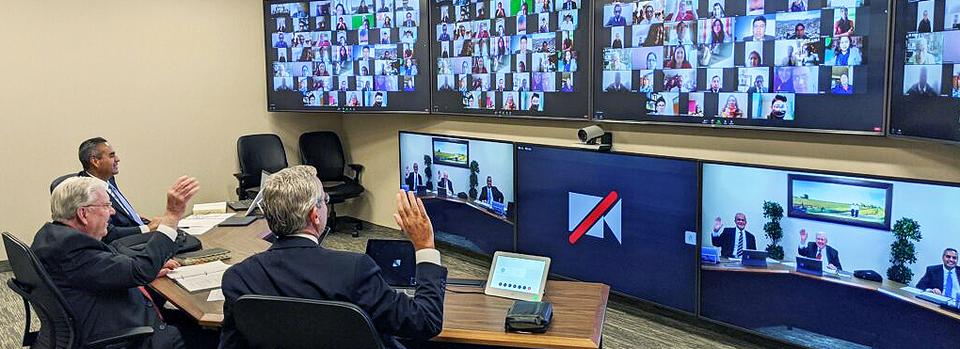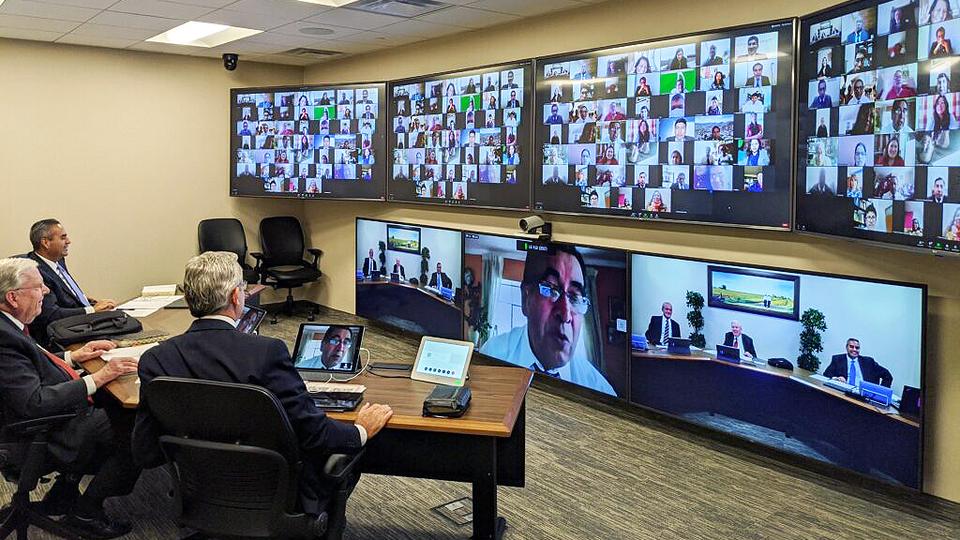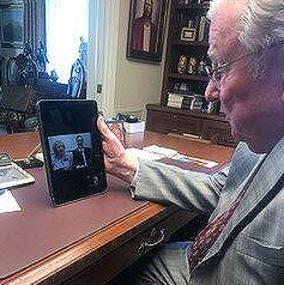
Apostles Zoom
From a multiscreen video-conference room in the Church Administration Building, President M. Russell Ballard, Elder Patrick Kearon and Elder Jorge T. Becerra wave to participants during the August 29, 2020, Cusco Peru Priesthood Leadership Conference. 2020 by Intellectual Reserve, Inc. All rights reserved.This story appears here courtesy of TheChurchNews.com. It is not for use by other media.
By Scott Taylor, Church News
Senior leaders of The Church of Jesus Christ of Latter-day Saints have long talked about “sitting knee to knee” with leaders of local wards, stakes and organizations in conferences and other instruction held across the globe. Likewise, members and missionaries worldwide speak of “sitting at the feet of an Apostle” in similar conference and devotional settings.
It has been the norm for decades as the Church’s general authorities and general officers have traveled to the four corners of the earth.
But given the current COVID-19 pandemic and its associated precautions and restrictions, such “knee to knee” and “at the feet” interactions are all but impossible due to social distancing, limited numbers at gatherings, travel restrictions and closed borders.
“We are in a different world,” said President M. Russell Ballard, Acting President of the Quorum of the Twelve Apostles. “But even though the pandemic hit the world, the Lord provided us a system whereby we could still stay in touch with our people.”
That “system” includes the wide-spread use of Zoom, Microsoft Teams and other similar software applications that deliver videoconferencing capabilities to the masses through desktop and laptop computers, tablets and smartphones.
“It is what we are doing now — every day,” President Ballard said in a recent Church News interview. “In fact, this morning we held our Quorum of the Twelve meeting — half of us were on the fifth floor, and the other half were home getting on via Zoom or in their office via Zoom.”
It’s not just happening within Church headquarters in Salt Lake City, Utah. Rather, videoconferencing is sustaining the worldwide reach of senior Brethren, general authorities and general officers.
“We are meeting with missionaries, with priesthood leaders, with sister leaders, in combined leadership conferences with both the men and the women,” President Ballard said. “And we don’t get on an airplane to do it.”
Of course, leaders would prefer to conduct conferences, devotionals and other instruction in person and to interact directly, he said, adding that through videoconferencing apps, participants can still see and hear each other and interact in conversational and question-and-answer settings.
“It is not like being in the same room where you can see their faces and shake their hands. But it is wonderful that you can do it, when you can get to them any way you can.”
The Acting President of the Quorum of the Twelve said he believes Latter-day Saints would be happy to know the Brethren are staying in touch with leaders, members and missionaries — “that when they can’t go personally like they used to, they are doing it through Zoom.”
Cusco Leadership Conference
That was evidenced by the recent Cusco Peru Leadership Conference, presided over by President Ballard from Utah and attended by leaders and members residing more than 4,500 miles (7,300 kilometers) away high in the Peruvian Andes Mountains, with the 11,152-foot (4,000-meter) elevation, more than 2 ½ times that of Salt Lake City in the Rocky Mountains.
Joining President Ballard was Elder Patrick Kearon of the Presidency of the Seventy and Elder Jorge T. Becerra, a General Authority Seventy and counselor in the South America Northwest Area. Elder Becerra is currently serving from Salt Lake City since pandemic restrictions have impacted international flights and visas and prevented his move to the area headquarters in Lima, Peru.

Apostles Zoom
From a multiscreen video-conference room in the Church Administration Building, President M. Russell Ballard, Elder Patrick Kearon and Elder Jorge T. Becerra wave to participants during the August 29, 2020, Cusco Peru Priesthood Leadership Conference. 2020 by Intellectual Reserve, Inc. All rights reserved.From Church headquarters, President Ballard and the others sat in front of several large video screens filled with subscreens of meeting participants, with highlighted viewing windows keying on individuals speaking or asking questions.
Six stakes headquartered in the Peruvian cities of Cusco, Juliaca, Puno and Sicuani and five neighboring districts were represented in the Saturday, August 29 leadership session by their respective stake, district and ward council members. The 350-plus participants included stake and district presidencies and their respective Relief Society and Young Women presidents and Young Men advisors as well as bishops and counterparts of the same ward organizations.
Elder Kearon, Senior President of the Seventy, encouraged bishops to delegate as much as possible to the Relief Society and elders quorum presidents, which enables the bishops to focus on the youth.
He also commended the youth leaders for helping the youth serve and lead each other, with Elder Kearon adding that it is vital that the adults not do all the leading for the youth.
Elder Becerra said that President Ballard told of having first visited the Cusco area 40 years earlier, and he encouraged attending leaders to realize the great blessing they had in knowing the truthfulness of the restoration of the gospel through the Prophet Joseph Smith.
“He invited each leader to engage in the work of salvation and exaltation. He taught that when we finish our mortal journey what will the Lord be most interested in [from] our lives,” said Elder Becerra. “Certainly, He will ask about our families, but He will be interested in knowing how many individuals we helped in bringing them unto Him and helping them repent and receive the blessings and ordinances of the gospel which are all centered on the Atonement of Jesus Christ.”
The Sunday member devotional, with more than 750 participating in the streamed broadcast on August 30, built upon a similar theme — building faith and confidence in the Lord Jesus Christ and His Atonement during the uncertainties and fears the Cusco-area Latter-day Saints are facing.
President Kimball’s Historic Address
Regarding the Cusco conference, both President Ballard and Elder Becerra individually made reference to President Spencer W. Kimball’s historic and prophetic April 1974 talk, “When the World Will Be Converted,” given on missionary work to general authorities and regional representatives.
“It’s full of revelation,” said President Ballard of the address, adding that the late prophet envisioned handheld devices to help others understand the gospel in their native tongues as well as advances of globe-spanning satellite technologies.
Elder Becerra noted that President Kimball mentioned towers — first King Benjamin speaking from a great tower in the Book of Mormon and then the day’s radio, television and microwave towers.
“It is my feeling that advances in technology have allowed the presiding Brethren to use virtual towers like unto the one King Benjamin built in the Book of Mormon,” he said, citing in Mosiah 2:7 when the king “caused a tower to be erected that thereby his people might hear the words which he should speak unto them.”
Elder Becerra continued: “In this way, we reach out to the one who seeks to know the will of the Lord, the mind of the Lord, the voice of the Lord, and the power of God unto salvation (see Doctrine and Covenants 68:4). I was privileged to watch an Apostle of the Lord Jesus Christ reach out individually to each member and their friends as he taught, lifted and invited them to secure their faith in the Lord Jesus Christ and claim the full blessings of the gospel in their live. This was done through modern towers that were caused to be erected.
“In the end, it was the hearts and minds of the people who were being erected as testimonies as principles, and doctrine were shared with people in Cusco, Peru.”
‘The Lord Knew What We Needed’

Apostles Zoom
President M. Russell Ballard, Acting President of the Quorum of the Twelve Apostles, conducts an online meeting with missionaries of the India New Delhi Mission in May 2020. 2020 by Intellectual Reserve, Inc. All rights reserved.President Ballard said he anticipates Church leaders will continue to use aspects of videoconferencing once the pandemic subsides and travel opportunities return.
“I think we’re learning a whole different way to communicate,” he said. “I think the expediency of being able to pull together a group of priesthood leaders or sister leaders and to see that group and teach them, and not have to take, say, three days to get to New Zealand and three days to get back and to be able to sleep in your own bed — that’s not too bad.
“Especially when you’re 92, which I will be in another month. So I think it’s been designed for President [Russell M.] Nelson and me,” quipped President Ballard, who, along with the 96-year-old Church President, shows few signs of slowing down. “We get out by technology — and it’s a tremendous, tremendous blessing.”
And so, as the general public has become more and more comfortable and adept at hopping on a Hangout, Skype or WebEx session for an interactive meeting, Latter-day Saints are doing the same for conferences, council meetings and interviews.
“They have to,” said President Ballard, “Because it’s either that, or there is no communication.
“And I think it will be like everything else — we’ll look back on this and say, ‘The Lord knew what we needed, and He is always ahead of us.’”
Copyright 2020 Deseret News Publishing Company